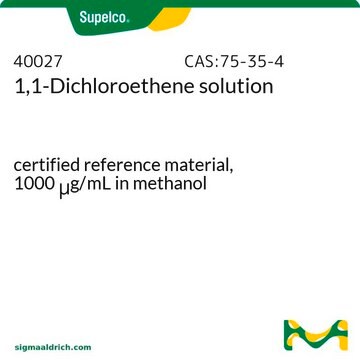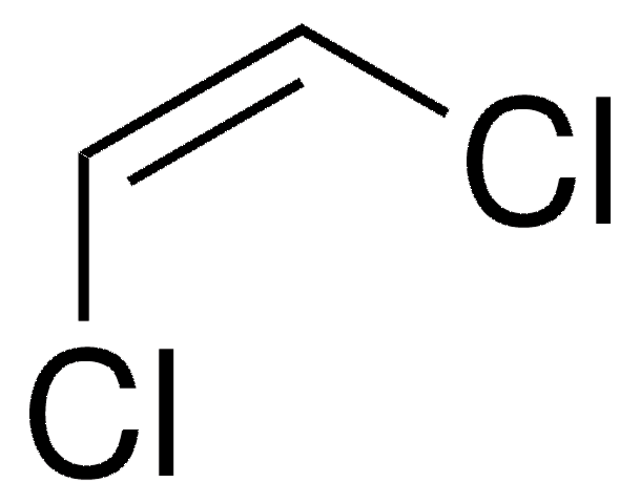02574
1,1-Dichloroethylene
analytical standard
Synonym(s):
Vinylidene chloride
About This Item
Recommended Products
grade
analytical standard
Quality Level
vapor density
3.46 (vs air)
vapor pressure
9.68 psi ( 20 °C)
Assay
≥99.9% (GC)
autoignition temp.
968 °F
shelf life
limited shelf life, expiry date on the label
contains
~0.02% 4-methoxyphenol as stabilizer
expl. lim.
15.5 %
technique(s)
HPLC: suitable
gas chromatography (GC): suitable
refractive index
n20/D 1.424-1.426
bp
30-32 °C (lit.)
mp
−122 °C (lit.)
density
1.213 g/mL at 20 °C (lit.)
application(s)
cleaning products
cosmetics
environmental
food and beverages
personal care
format
neat
storage temp.
2-8°C
SMILES string
ClC(Cl)=C
InChI
1S/C2H2Cl2/c1-2(3)4/h1H2
InChI key
LGXVIGDEPROXKC-UHFFFAOYSA-N
Looking for similar products? Visit Product Comparison Guide
General description
1,1-Dichloroethylenes are a group of volatile organic compounds (VOCs), which are characterized by high vapor pressure and low water solubility.
Application
Signal Word
Danger
Hazard Statements
Precautionary Statements
Hazard Classifications
Acute Tox. 4 Inhalation - Acute Tox. 4 Oral - Aquatic Chronic 3 - Carc. 2 - Eye Irrit. 2 - Flam. Liq. 1 - STOT RE 1 Inhalation - STOT RE 2 Oral
Target Organs
Liver, Nose
Storage Class Code
3 - Flammable liquids
WGK
WGK 3
Flash Point(F)
-9.4 °F - closed cup
Flash Point(C)
-23.0 °C - closed cup
Personal Protective Equipment
Regulatory Listings
Regulatory Listings are mainly provided for chemical products. Only limited information can be provided here for non-chemical products. No entry means none of the components are listed. It is the user’s obligation to ensure the safe and legal use of the product.
PRTR
Class I Designated Chemical Substances
FSL
Group 4: Flammable liquids
Special flammables
Hazardous rank I
ISHL Indicated Name
Substances Subject to be Indicated Names
ISHL Notified Names
Substances Subject to be Notified Names
JAN Code
02574-VAR:
02574-1ML:4548173982656
02574-5ML:4548173982663
02574-BULK:
Choose from one of the most recent versions:
Already Own This Product?
Find documentation for the products that you have recently purchased in the Document Library.
Customers Also Viewed
Protocols
US EPA Method TO-17: GC Analysis of Volatiles on VOCOL® after Collection/Desorption using Air Toxics Tube
Our team of scientists has experience in all areas of research including Life Science, Material Science, Chemical Synthesis, Chromatography, Analytical and many others.
Contact Technical Service









